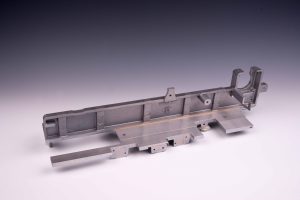This part is for a customer in the medical industry. The component assembles onto testing equipment to analyze samples.
The part was originally produced by fabrication. The supplier(s) separately machined 5 different pieces, welded them together, then machined it again.
The engineering team wondered… is there was a better way to manufacture this piece? Since, Batesville Products already supplied a different component for to this customer, the engineering team felt confident asking us for advice.
We simplified the machining and welding process by casting this product into one solid piece of aluminum!
This component has a very complex geometry with multiple walls. To cast as one piece, we made a reusable, steel permanent mold with pull cores. The part was cast to a near-net shape, then we used a secondary machining operation to fine-tune critical details.
The new manufacturing process saved time and money, while still producing a precise, functional component. Permanent mold casting stands out from fabrication and sand casting due to its great surface finish, strength, tight tolerances, and low porosity. Low-porosity aluminum castings are necessary for medical equipment to ensure leak-free, clean parts!

Producing a high quantity of fabricated parts means lots of welding labor time and cost. Sourcing multiple pieces means managing multiple drawings, coordinating purchasing and shipping, and extract inspection time. Can your part be manufactured better?
Get quotes! The cost typically comes down to a balance between EAU and complexity.
If you’re only manufacturing a couple pieces a year, fabrication will probably be your best option. If you’re fabricating about 500 pieces a year or more, casting may give a better ROI. For small, simple parts with a few drilled holes, we recommend machining from stock.
Permanent mold casting is great for unique, asymmetrical parts with lots of different walls and internal or external geometry. You can quickly create a repeatable, precise, near-net shape and even add secondary machining for critical tolerances. Fabrication can produce complex parts by machining and welding pieces together as many pieces as you want. However, keep in mind the more pieces you weld together, the higher the production cost and time.
Additionally, fabricated joints are potential weak spots. Castings are more structurally sound, being produced as one solid piece.
If you’re not sure where to start, ask trusted suppliers for advice. We look at parts like yours and answer manufacturing questions every day! We’ll help lead you to the best manufacturing method for your situation.